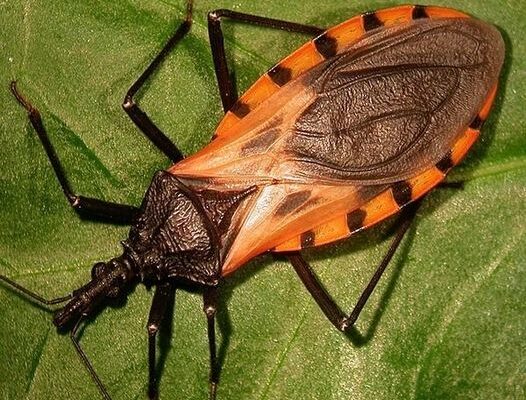When Emiliana Rodriguez was young, she remembers seeing her friends play soccer at night when suddenly, one of the players collapsed and died right there on the field.
Rodriguez, who was from Bolivia, didn’t know what had happened, but she became really scared of the dark and the “monster” that she learned about. This monster, called Chagas, was said to come out only at night, and it made her even more afraid.
Chagas disease is a special kind of sickness that is transmitted by insects that are active at night. It’s often called the “silent and silenced disease” because it affects around 8 million people each year and causes about 12,000 deaths on average.

Emiliana Rodriguez, 42, discovered she had to live with Chagas, a “monster,” after relocating to Barcelona from Bolivia 27 years ago.
“Nighttime was usually when I felt scared. I didn’t always get a good night’s sleep,” she confessed. “I was afraid that I might not wake up in the morning.”
When Rodriguez was eight years old and pregnant with her first baby, she had to take some special tests. The results showed that she had the Chagas gene. She remembered her friend who had passed away and said, “I was in total shock and thought about all the stories my family shared about people who died unexpectedly.” She also thought, “What will happen to my baby?”
Rodriguez was given medication to stop the parasite from passing to her baby before it was born. When her daughter arrived, she tested negative for the disease. Elvira Idalia Hernández Cuevas, who is 18, didn’t know about the dangerous disease from Mexico until her son, who is also 18, was found to have Chagas.
Idalia, an 18-year-old who donates blood, comes from a town close to Veracruz, Mexico. When her blood sample was tested, she found out she had Chagas disease, which is caused by bugs called triatomine bugs, also known as vampire or kissing bugs, that suck blood.
In a chat with the Guardian, Hernandez mentioned, “I began looking up Chagas online since I had never known about it before.” When I found out it was called a silent killer, I got really scared. I didn’t know where to turn or what steps to take.

She isn’t the only one; many people don’t know about the diseases that these nasty bugs can cause. The name Chagas comes from Carlos Ribeiro Justiniano Chagas, a doctor and researcher from Brazil who found the first human case in 1909.
Over the past few decades, reports of the incidence of Chagas disease have been made in Europe, Japan, Australia, Latin America, and North America.
Kissing bugs usually live in the walls of houses in rural or suburban areas, especially in places where people have low incomes. They are most active at night when everyone is sleeping. These bugs bite animals or people and then leave their waste on the skin. If the person scratches the bite, they might break the skin, or they could accidentally get the bug’s waste in their mouth or eyes. This is how the T. cruzi infection spreads.
The World Health Organization (WHO) believes that around 6 to 7 million people around the globe, which includes about 8 million in Mexico, Central America, and South America, are affected by Chagas disease. Most of these people don’t even know they are sick. The Centers for Disease Control and Prevention (CDC) provided these numbers. If Chagas disease is not treated, it can be deadly. The Guardian reports that this disease causes more than 12,000 deaths each year, making it the deadliest parasitic disease in Latin America, even more than malaria.
Despite the fact that these bugs have been found in the United States—nearly 300,000 people are infected—they are not thought to be endemic.
Some people might not feel any symptoms at all, but the CDC says that about 20 to 30 percent of individuals can have stomach or heart issues that lead to really bad pain many years later.

Furthermore, only 10% of cases are detected globally, which makes prevention and treatment exceedingly challenging.
Hernández and her daughter Idalia visited several doctors looking for help, but none of them knew much about Chagas disease or how to treat it. Hernández said, “I was shocked, scared, and really sad because I thought my daughter might die. What worried me the most was that I couldn’t find any reliable information.”
Idalia finally got the care she required after receiving assistance from a family member who was employed in the medical field.
Hernández says that the Mexican government is wrong when they say Chagas disease is under control and not affecting many people. He believes that many doctors confuse Chagas with other heart problems because they don’t know enough about it. Also, a lot of people in Mexico don’t even know that Chagas disease exists there.
The World Health Organization (WHO) has labeled chagas as a neglected tropical disease, indicating that it is not a priority on the global health policy agenda.
Chagas disease often gets ignored, and Colin Forsyth, who is a research manager at the Drugs for Neglected Diseases Initiative (DNDi), explains that this is partly because it’s a quiet illness. It can remain unnoticed in your body for a long time since the early stages don’t show any symptoms.
Forsyth mentioned that the people who are impacted really lack the ability to change healthcare rules, especially when talking about poor communities. This issue is often overlooked because of a mix of social and biological reasons.
Chagas disease is getting more attention now because it’s spreading to different continents. It can also be passed from a mother to her baby during pregnancy or childbirth, and it can be transmitted through organ donations and blood transfusions.

The Chagas Hub, located in the UK and started by Professor David Moore, who works at the Hospital for Tropical Diseases in London, aims to help “more people get tested and treated, and to reduce the risk of transmission, which in the UK happens mainly from mother to child,” as stated by Professor Moore.
Regarding the WHO’s 2030 aim for the eradication of the disease, Moore stated that progress toward it is “glacial” and added, “I can’t imagine that we’ll be remotely close by 2030.” That seems improbable.
Benznidazole and nifurtimox are two medicines that have been used for over 50 years to treat Chagas disease. However, according to Moore, these drugs are “toxic, unpleasant, and not very effective.”
Although the medications are effective in curing babies, there is no guarantee that they will prevent or halt the advancement of the condition in adults.
When it comes to serious side effects, Rodriguez recalls feeling dizzy and sick to her stomach, plus she had a rash with hives. She finished her treatment and now goes for check-ups every year.
Moore mentions that it’s really important to develop better anti-Chaga medications to help stop the disease from spreading. However, he points out that drug companies aren’t really interested in doing this because it doesn’t make them enough money.

Hernández, who is the president of the International Federation of Associations of People Affected by Chagas condition (FINDECHAGAS), is working hard to spread the word about Chagas disease. He believes that more people need to know about it until there is a bigger demand for new and better treatments.
In Spain, Rodriguez is fighting against the “monster” to help raise awareness about Chagas disease. This effort is part of a campaign organized by the Barcelona Institute for Global Health.
“I’m tired of hearing nothing at all,” Rodriguez declares. “I want Chagas to be discussed and made public. I’m in favor of testing and therapy for individuals.
They are being heard, too.
World Chagas Disease Day was created by the World Health Organization (WHO) on April 14, 1909, which is the day Carlos found the first human case of the disease. The WHO mentions that there are 20 different diseases and categories that they want to prevent, control, eliminate, and get rid of by 2030, and Chagas is one of them.
To prevent a possible infestation, the CDC suggests taking the following steps:
- Make sure to fill in any spaces and cracks around doors, windows, walls, and roofs.
- Remove the rocks, wood, and piles of brush that are near your house.
- Install screens on your windows and doors, and make sure to repair any rips or gaps in them.
- Fill in any holes and cracks that go to the outside, the crawl spaces under the house, and the attic.
- Make sure to keep your pets indoors, especially at night.
- Keep your house and any spots where your pets hang out outside clean, and make sure to look for bugs often.

If you think you’ve found a kissing bug, the CDC suggests not squishing it. Instead, gently place the insect in a jar, add some rubbing alcohol, and then put it in the freezer. After that, it’s a good idea to take the jar to a science lab or your local health department so they can help identify it.
Please tell this tale to help spread the word about an illness that goes unnoticed!


